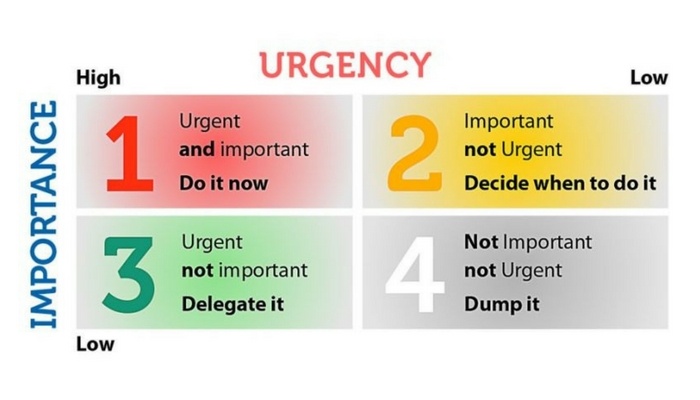
You wake up at around six and check your phone – there’s a message from your boss or coworker. You’re awake, so you respond. At the time this probably didn’t seem like much of a big deal, but then you notice something. You start getting more and more early morning or late texts and emails. Before you know it, your work life has spilled over into your weekend.
While you sit at brunch with your friends, halfway through a plate of pancakes, your phone dings: “Did you check with our vendor about the updated timeline?”
And again, midway through a late night jog, a notification interrupts your running playlist. When you stop, panting, you see your boss asking “When can I expect you to have this copy completed?”
At this moment, you might find yourself asking “When can I expect a break?”
Having the lines blurred between when work ends and recharging begins isn’t any fun. It isn’t always something that happens intentionally, but the impact is the same. Even if someone sends an email with just an innocent, top-of-mind thought, that thought now becomes yours to think about during off hours.
Since I’ve started working with The ONE Thing team, I’ve heard from a number of people that boundaries, when not clearly defined, become a slippery slope. And with the advent of technology, trying to maintain boundaries with bosses, coworkers and even significant others has become infinitely more challenging.
But boundaries are important!
They help protect our time, energy, and resources when it comes to working on our ONE thing. If you find yourself struggling with your boundaries, try implementing these simple tactics.
Articulate What You Want
Everyone has boundaries. Hard lines we set for ourselves about how we like to be interacted with. Boundaries are tricky when we haven’t thoughtfully articulated them to those around us. Often, the only way we end up expressing that they exist is when they’ve been crossed.
Waiting until a boundary has been crossed to express its existence is counterproductive and a waste of time. Instead, take the time to sit down and really think about what your boundaries are and write them out.
One of the best tools you can use to help these problems is to go through an Honest Expectations exercise. We use this exercise to establish our preferences for workplace behavior. (But it can be used for personal relationships, too.)
We ask questions like:
- How honest do you like others to be with you?
- How do you best handle conflict?
- How do people win with me?
- How do people lose with me?
These expectations are a great way to put everything out there so people have a clear understanding of how you like to be worked with, spoken to, and feel respected. It opens up the door to collaboration and understanding and gives people a common language to draw from when boundaries aren’t being honored. More than that, this type of dialogue is also an opportunity to set standards for all parties involved.
When we set standards, everyone is elevated. When we don’t have standards, everyone sinks to the lowest common denominator. If your standards include being a more present parent or partner – great! Let people know you want your weekends uninterrupted by work related emails so you can focus on your family. When these expectations are set with those around us, it also enables them to understand what they can expect out of us. For instance, if an email does wind up in our inbox on a Saturday afternoon, our coworker is already aware that they likely won’t hear back until Monday morning.
Applying standards keeps us accountable to ourselves. In other words, it helps us know when we are living up to our potential and when we’re falling short. Standards create boundaries for us to live and work in.
Use Technology to Your Advantage
When we have constant access to email, text, and Slack at our fingertips, it can be tempting to just… check one more email and respond.
Stop that.
You need to respect your time as much as others do, and when you give in to the temptation to check your work email every five seconds, you’re setting a bad precedent for yourself and those you work with.
If you find yourself struggling to disconnect, try and make technology work for you instead of against you. Most smartphones, laptops, and other devices have a number of ways you can limit your use.
When you’re going on a date or spending time with friends, put your phone on “Do not disturb.” Set social media or app limits for yourself for each day. Install software on your computer that monitors how much time you spend messing around on games or the internet. Try to disconnect from WiFi for a few hours.
Although it’s important to not use technology as a crutch to build good habits, if you’re really struggling, having those failsafes in place can help keep you on track. Especially when you’re having difficulty respecting your own boundaries.
Remember Your Priorities
One of the best ways to learn what your boundaries are, no matter where you are or what you’re doing, is to remember your priorities.
Recently, I attended the Texas Conference for Women, where I heard Eat, Pray, Love author Elizabeth Gilbert speak. During her speech, she discussed her time with her late partner, Rayya Elias.
Gilbert discussed the clarity she gained after learning her girlfriend was diagnosed with cancer. Where before, she often had difficulty wading through the noise and ranking her priorities, her life suddenly became entirely focused and clear. She deleted all of the emails from her inbox. She put aside her book project. Instantly, she knew that she only had one priority and ruthlessly put up boundaries to make sure she spent all of her time, energy and attention on Rayya.
As she put it in one interview, “Death—or the prospect of death—has a way of clearing away everything that is not real…”
If you’re having difficulty with boundaries, part of the problem may be that you don’t understand what your actual priorities are. If you’re struggling to figure out what matters and needs to be done, try using the Eisenhower Matrix to sift through the noise.

This matrix requires us to separate out “what and “when”, so we can prioritize our time in an ideal way. All of our most pressing and demanding tasks belong in Box 1 — they need to happen and they need to happen now. These are likely tasks that have to do with your ONE Thing.
Tasks that may not demand as much urgency, but still rank as something highly important, find a home in Box 2. These are things that belong on your calendar and may eventually fall into your ONE Thing, but that don’t necessarily need your attention just yet.
Everything that falls into Boxes 3 and 4 can either be put off until later or leveraged off to someone else.
If you’re struggling to put up boundaries around yourself and your time, take a moment to think about this matrix. Is what someone is asking you to do tied to your ONE thing? Is it time sensitive? Can someone else do it?
If the answer to any of these is ‘no,’ then it isn’t a priority. Become comfortable with identifying what matters, prioritizing around your ONE thing, and learning to say ‘no.’ Because the word ‘no’ is a powerful tool we can use in support of our boundaries.
For more information about saying ‘no,’ check out our webinar with Alex Sheen. Or if you’d like to learn more about priorities and habit building, check out some of our handy guides on our resources page.
